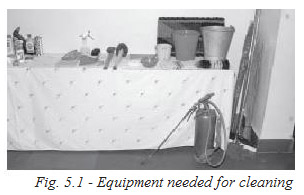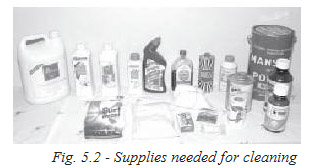Various equipment and supplies are used to keep the hospital clean and hygienic. The housekeeper must make a careful selection of equipment based on its suitability for a health care institution, appropriate design and size, rugged construction and finish, easy availability of materials for maintenance, initial and operating costs, pre-tested on-the-job performance, safety, and overall efficiency. The housekeeper should also research supplies and develop basic procedures on how to effectively use them to maintain desired standards of cleanliness.
Housekeeping property is broadly classified as either equipment or supplies. Generally, equipment such as brooms, mops, stools, vacuum machines, are reusable, and supplies such as dusters, detergents, germicides, are consumables. (Fig. 5.1 & Fig. 5.2)
Purchasing equipment
Poor economy is buying anything below high quality and time consuming equipment. Buying good equipment and letting it lay idle or buying a product of better quality than is needed is also poor economy. Comparing the results of a trial use (in case of equipment), or sampling, (in case of supplies) to the performance of similar items already in use is beneficial before placing an order for a new one.
The housekeeper is responsible for selecting new equipment. The housekeeper may obtain advice from any personnel involved with the equipment, be they the purchasing agent, maintenance superintendent, laundry manager, or microbiologist, but the final decision rests with the housekeeper. If the housekeeper discovers that any equipment is inadequate, it must be personally observed and research the market to obtain knowledge about the different advancements and technology that is available for that one equipment. Only then can they understand the limits of expectation from one such equipment. A general checklist can be formulated to help the housekeeper and other personnel involved in the purchase of the equipment to remember every factor pertinent to the purchase of the equipment.
The housekeeper also needs to evaluate a product before purchase. Very often the employees who use the product are the best people to consult for this. In the initial stages of introducing a new type of equipment the general trend should be monitored. Making a checklist can help in this process. For example when monitoring a new type of mop, list who the distributor is, the cost, how often it needs to be replaced. If the mop is being used in different areas, monitor whether the durability, usability varies from one area to another and investigate why.
For ensuring long life of a machine it is necessary to provide appropriate storage space and create awareness among the users to put it back into its place as soon as they complete their work.
Maintaining equipment
When an employee is provided with high quality equipment, he must be trained in its proper care, use and storage. All equipment should also be inspected daily by the housekeeper or by a representative for cleanliness, indications of wear and tear, neglect or abuse. In case of heavy machinery, ask the distributor to agree on a contract for periodic detailed inspections to forestall breakdowns.
Some institutions hold workers responsible for the equipment assigned to them. Other equipment that is used by the department for general work, and which is shared by all the staff, is cared for and inspected regularly by the senior housekeeper, or a person assigned for the purpose. One method to ensure regular inspection is to set aside a specific room where equipment is turned in at the end of the day and made ready for use the next day. Another method is the systematic tagging of machines that have been inspected. This makes it easy for the housekeeper to make a quick check of machines that have not been inspected.
A card file with separate cards for each equipment’s service history should be kept in the housekeeping department which will provide the department with important data whenever replacement of equipment is being considered. In case of failure, a tag stating “defective’ should be attached to the equipment, and the equipment should be checked by the maintenance department. Space should be provided on the tag for a brief description of the defect, the department from which it was sent, the date on which it was sent, and the name of the person who discovered the defect.
The manufacturer’s instructions concerning the operation, maintenance and adjustments of the equipment should be permanently kept in the housekeeper’s file. Copies should be given to the maintenance department for making repairs and to use the parts list for stockpiling small replacement parts. Each employee should be given individual instruction in handling the equipment they use, and should have a set of instructions framed and hung in the immediate work area. When training an employee to use new equipment, observe the employee as he uses the equipment to evaluate how closely he adheres to the instructions.
If the maintenance department does not have workers with the skills required to repair particular equipment, using the services of the manufacturer’s local representative for systematic maintenance and overhauling is advisable. By contracting his services, the institution need not stock up any spare parts, and it can avoid loss of time, as he can provide substitute equipment while repairs are being made.
Equipment and supplies needed for housekeeping
Duster : To clean dust from tables, chairs, and other articles.
Broom (hard bristle): To clean the surroundings, the toilets, and to remove water after washing the floor. It is also used to sweep rough flooring.
Softbroom : To sweep dust and waste on a smooth floor.
Waste Basket : Placed in the patients’ rooms, office area and common areas of the hospital for dropping waste materials.
Dust bin : All the garbage collected from different areas of the hospital is put into the dust bin.
Dust pan : To pick up and remove dust and waste collected at a place.
Rugs : Placed at the entrances to absorb all the dust particles from peoples footwear when they come in from outside.
Door mat : Placed in front of the entrance, operation theatre, laboratory, other rooms, toilets and bathrooms, in order to absorb moisture and dust.
Disinfectant : Different disinfectants for disinfection are used for cleaning floors and toilets.
Floor cleaning liquid : To clean and remove dirt from the floor.
Bucket : To carry water and while swabbing the floor and also to carry cleaning equipments from one place to other.
Thread mop :To clean and mop the verandah and rooms.
Swabbing cloth : To wipe bathrooms and small areas and keep them dry.
Washing liquid / powder : To clean bathrooms, toilets and washbasins.
Liquid soap / Soap solution : To clean walls and tiles.
Bleaching powder : To clean moss-covered places, sewage tanks and water tanks.
Scrubber : To scrub washbasins, vessels and remove stains.
WC brush : To clean the outlet for sewage water.
Wooden brush : To clean the footrests and tiled flooring in the toilets and to clean water tanks.
The wooden brushes that are used to clean toilets should not be used for any other purpose.
Curved brush : To clean the inside of the commode and toilet bowl, as well as corners and edges.
Nylon sponge : To clean walls and tiles.
Nuvon : An insecticide that is sprayed to prevent cockroaches, mosquitoes, ants and flies, and placed in septic tanks to prevent breeding of cockroaches
Insecticide : Sprayed or used in powder form to prevent cockroaches, flies, and other insects.
Naphthalene balls : Placed in the drains of washbasins to prevent insects from coming up through the drains, and to prevent bad odours.
Air freshener : Placed in the toilet, stalls or in rooms to drive away odour
Hydrochloric acid : Used to remove stains on washbasins and toilets and to remove any clogs in the washbasins and sinks.
Harpic / Toilet cleaner : To remove stains on tiles and in toilets and make them sparkle .
Brasso : To polish brass articles.
Mansion polish : To polish floors.
Stain remover : To remove stains and dirt from clothes.
Varnish : To polish wooden furniture and protect them from termites.
Floor stain removing stone : To remove salt stains from mosaic flooring.
Toilet paper : A roll of toilet paper is placed in the toilets.
Vaccum cleaner : Amachine used to remove cobwebs and dust from places that are not easily reached, such as corners of walls, and ceilings, window grills, and mosquito mesh
Scrubbing machine : A machine used to scrub the floors and keep them clean
Polishing machine : To polish floors and keep them shining
Multi-action mop : To clear water from the floor. It is used in the bathrooms to dry up the floor, as well as to clean it thoroughly.
For a demonstration on the equipment and supplies used for cleaning, please watch the video of the CD.
Student exercise
Answer the following
- What are the important factors to be kept in mind when purchasing equipment?
- What are the different ways that maintenance of equipment can be organised in the housekeeping department?


